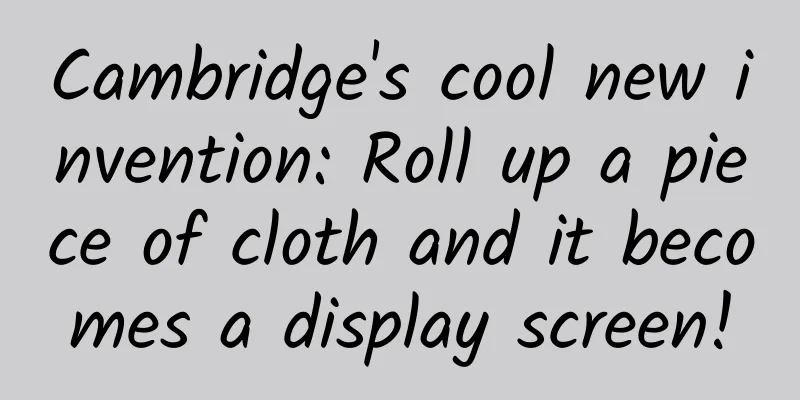Cambridge's cool new invention: Roll up a piece of cloth and it becomes a display screen!

|
Written by: Wu Tingting Editor: Kou Jianchao One morning, you are woken up by the fifth alarm you set last night. The curtains in front of you are showing you the weather, traffic and other information for the day. Before getting out of bed, you can check the sleep and health indicators displayed on the quilt. Your phone can be charged by placing it on the carpet. Even your clothes can act as touch screens, allowing you to handle work anytime, anywhere... Does this sound like a scene from a science fiction novel? No, no, no! Now, a research team at Cambridge University may make all this a reality: They have developed a textile-based smart display screen, integrating smart sensors, LED displays, and power collection and storage directly into the textile. It can not only display graphic information in real time and interactively touch, but can also be bent and folded at will. "A piece of cloth is a display screen." Figure | Smart textile display can be folded, bent, and rolled up at will (graphic source: Nature Communications) It is reported that this technology uses a completely fiber-based manufacturing method for the first time to integrate scalable, large-area complex systems into textiles. It has great potential to be integrated into everyday objects and directly put into large-scale mechanical production. The relevant research paper, titled "Smart textile lighting/display system with multifunctional fibre devices for large scale smart home and IoT applications", has been published in the scientific journal Nature Communications. When Textiles = Electronic Displays With the popularization of concepts such as "smart home" and "Internet of Things", smart textiles have now become one of the focuses of scientists. If the textiles that can be found everywhere in the streets and alleys can serve as various electronic devices, our lives will surely become more convenient and cooler. However, at present, the functions, sizes and shapes of smart textiles are still limited by manufacturing processes and cannot meet this demand. In recent years, relevant research has proposed that certain special "smart fibers" can be directly integrated into textiles through traditional weaving or knitting processes. Once successful, it means that they can be made into everyday items, greatly expanding the potential applications of smart textiles. In this study, the research team successfully produced an intelligent textile system called F-devices. The prototype device is approximately 46 inches. Although it looks no different from ordinary cloth textiles, it can be operated as an electronic display screen to monitor and display radio frequency signals, temperature, light, touch information, and biosensor information in real time. It can also automatically collect and store electricity. Figure|Smart textile display screen display (graphic source: Nature Communications) At the same time, because it is made directly using commercial textile manufacturing technology and the raw materials are textile fibers, it can be rolled and folded at will, and has flexibility and toughness that were difficult to achieve with previous smart textiles. Figure | Textile-based smart display (Source: Nature Communications) The research team said that the prototype display manufactured this time paves the way for the next generation of electronic textile applications, which may involve areas such as smart and energy-saving buildings. For example, buildings using smart textile technology can generate and store energy on their own. In addition, the Internet of Things, distributed sensor networks, and flexible and wearable interactive displays integrated with textiles will take a big step forward. Multiple functions in one, so cool! So, how is this system implemented? First, the research team integrated six major fiber components: F-RF antenna, F-photodetector, F-touch sensor, F-temperature sensor, F-biosensor module, and F-energy storage module, and used RGB fiber as raw material to realize the multiple functions of the display screen. Figure | a) Six key components embedded in F-devices; b) The system is woven directly using the mechanical textile technology in the workshop; c) Prototype intelligent textile system (Source: This paper) Among them, photoelectric detectors and temperature sensors are used for environmental monitoring. After receiving input signals (such as being irradiated by ultraviolet rays), the smart display screen will display the current information in real time. Figure | The research team used ultraviolet light to illuminate the optical sensor, and the display screen played the corresponding information (graphic source: Nature Communications) Figure | Smart textile display monitors in real time and displays current temperature changes in the form of graphs (graphic source: Nature Communications) Biosensors are used to detect various indicators of the human body. During the experiment, staff used the system to read their own heartbeats, and the display showed the electrocardiogram in real time. Figure | Smart textile display monitors heartbeat and displays electrocardiogram in real time (graphic source: Nature Communications) The touch sensor is designed to operate each fiber optic device and displays a set of pre-coded instructions on the textile display when it receives a touch. In order to achieve real-life applications, the research team also added 30 execution terms related to smart gadgets and the Internet of Things (table on the left of the figure below): Figure | When the touch sensor receives different input signals, it triggers the corresponding instructions and displays them on the display (graphic source: Nature Communications) In addition, the research team also integrated a power collection and storage module into this smart textile display to ensure that the display can be independently powered for 5 minutes. Figure | The power storage module is supplying power to the display screen, which can last for about 5 minutes (graphic source: Nature Communications) There may be great things to do in the future In addition to the excellent functional realization, in order to perfectly integrate the smart display with the weaving process, the research team also coated each fiber component with a material that can withstand sufficient stretching so that they can be directly used in textile manufacturing machinery. In addition, in order to improve the reliability and durability of the smart display, the research team also wove some fiber-based components. After 1,000 mechanical and electrical stability tests and waterproof tests, it was found that the optical fiber components had no mechanical damage and the performance deviation was maintained within a stable range. Figure | The research team tested the waterproofness of F-devices (graphic source: Nature Communications) Finally, the research team used conductive adhesives and laser welding techniques to connect multiple fiber optic components together and successfully integrated multiple functions into a large piece of robotic textile through standard scalable textile manufacturing processes. In this regard, Jong min Kim, professor of engineering at the University of Cambridge and one of the leaders of this study, said: "Our approach builds on the convergence of micro- and nanotechnology, advanced displays, sensors, energy, and industrial textile manufacturing, and is an important step toward fully leveraging sustainable and convenient electronic fibers and e-textiles for everyday applications." Currently, the research team is continuing to study how to improve the sustainability of the technology and how to apply it to everyday objects, and is working to integrate sustainable materials into fiber components to propose a new type of textile-based energy system. These flexible and practical smart textiles can eventually be made into batteries, supercapacitors, solar panels and other devices. As another of the study leaders, Luigi Occhipinti, Professor of Engineering at the University of Cambridge, said: “By integrating fiber-based electronic, photonic, sensing and energy functions, we can enable a whole new class of smart devices and joined-up systems. This research is an in-depth exploration of the potential of textile manufacturing, through which we will soon see energy-autonomous smart IoT devices that can be seamlessly integrated into our everyday objects and many other industry applications.” What do you think about smart textiles? Feel free to share in the comments section~ References: https://www.nature.com/articles/s41467-022-28459-6#Fig4 https://www.techexplorist.com/fully-woven-smart-display/44664/ https://techxplore.com/news/2022-02-scientists-fully-woven-smart.html Academic headlines |
<<: Evaluation of 35 charging cables: Is it a waste of money to spend 145 yuan on the cable?
Recommend
Professional Editor - Master Class
Professional Editor-Master Class Xuelang Resource...
When spring comes and flowers bloom, go to the mountains, but don’t neglect ice and flood prevention!
Some time ago, when people were immersed in the b...
Dragons used to look like pigs, and also looked like...
The dragon has been a symbol of the Chinese natio...
Double 11 is here! How do those bidding veterans operate their accounts?
" Double Eleven has begun, has your traffic ...
Low cost, high exposure, advertising optimization model!
How to optimize the effectiveness of advertising,...
How to use growth hacking thinking for promotion?
Back to August 1, 2017, at 11:23 am, I was still ...
National Safe Medication Month丨Starting from the smell, interesting talk about the "four qi and five flavors" of traditional Chinese medicine in Chinese characters
Author: Yang Yajin, Department of Pharmacy, 9th 9...
The valuation impulse behind Xiaomi, Meizu, and Hammer's concentration on the low-end
Yesterday, Smartisan released its 1,000-yuan smar...
Taking the wine brand as an example, let’s explore the four major routines of brand copywriting!
Since ancient times, wine has been loved by liter...
【Wu Xiaobo】My Real Estate Planning Series Course Member
Course list 1 "Family Asset Allocation" ...
8 ideas for Baidu promotion plan
In fact, promoting the Internet is not difficult,...
16 Must-Have Figma Plugins for UI/UX Designers
Editor's Note: Which Figma plugins are essent...
Essential knowledge for APP mobile search promotion, practical introduction of Baidu Chunhua!
Baidu's APP promotion is mainly divided into ...
Xue Zhiqian has been all over the WeChat Moments! Why did Tencent choose him?
Since last night, Xue Zhiqian has been all over t...
Is the “one-letter difference” between aviation and aerospace a “thin line of separation”?
Are aviation and aerospace the same thing? This i...


![Video account sales tutorial: Teach you how to make health tea step by step, and easily earn 100,000+ yuan a month [Video course]](/upload/images/67cc3051d7fd9.webp)






